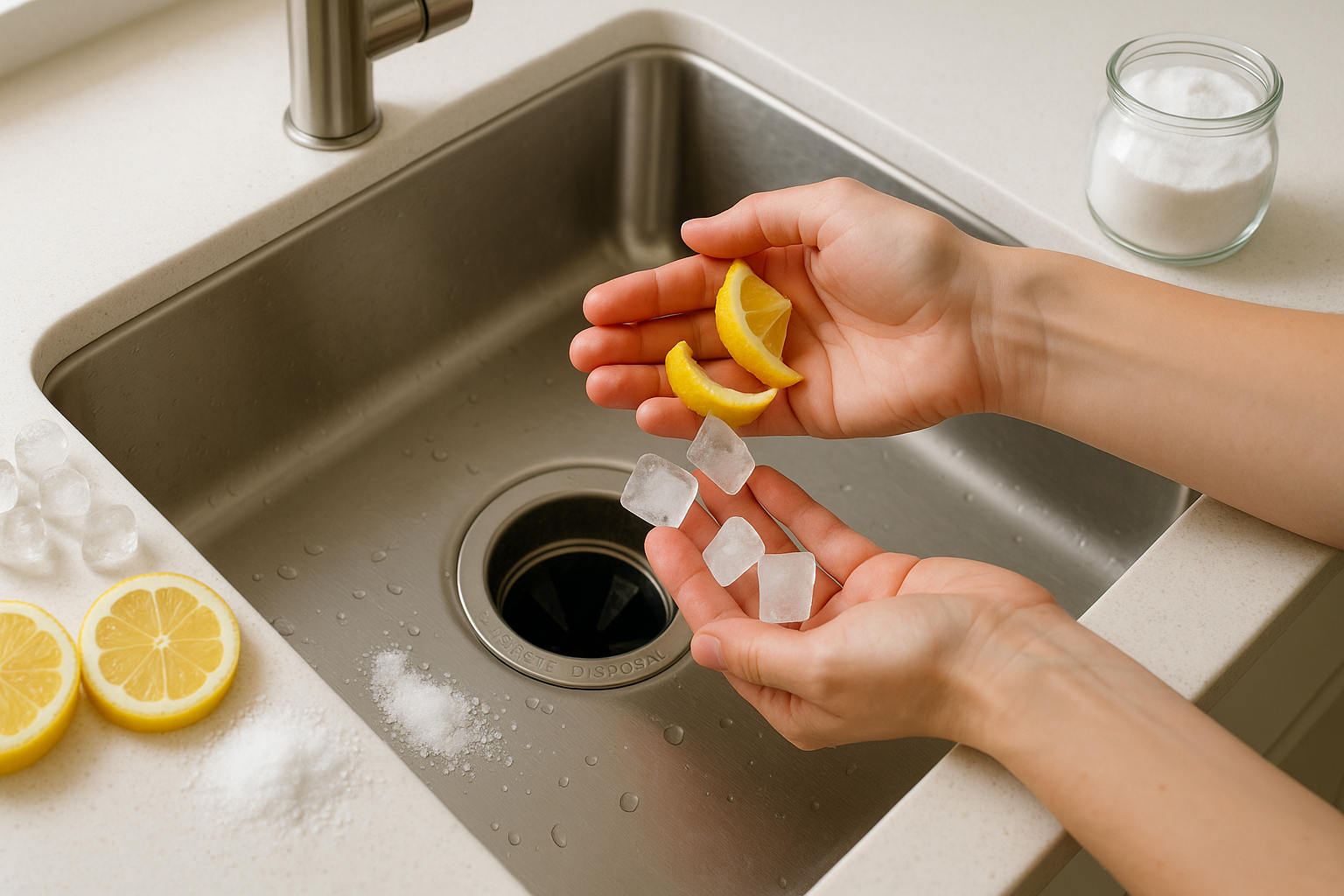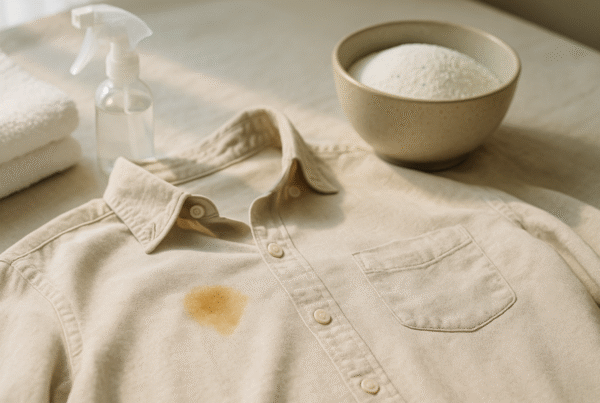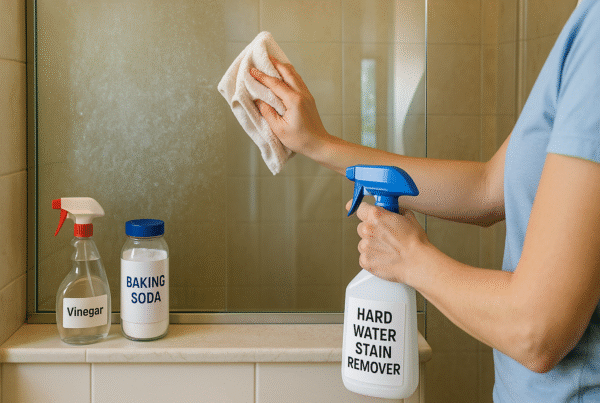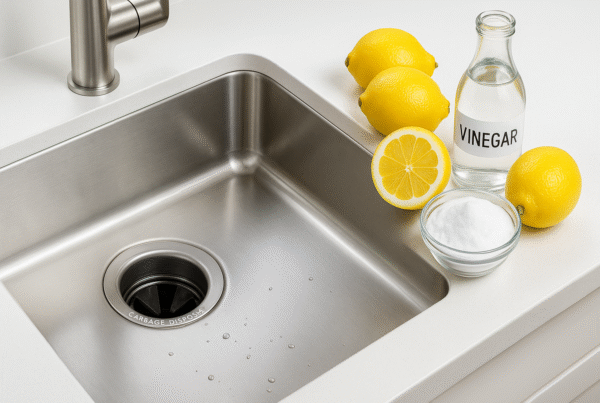Did you know that learning how to get rid of a garbage disposal smell with ice is one of the best tricks using simple ice cubes? Paul Abrams from Roto-Rooter Services says this simple household item can work wonders on smelly disposal units. It’s an affordable and surprisingly effective cleaning solution.
When your kitchen fills with that unpleasant garbage disposal odor, skip the pricey cleaners. Experts suggest using ice-based solutions, such as cleaning a garbage disposal with ice and salt, to scrub away grime. Or try ice and lemon; the peels clean while the oils freshen the air. Ice and baking soda go even further, fighting bacteria and stuck-on residue.
In this article, we’ll explore four expert-approved methods for getting rid of the garbage disposal smell with ice. These methods are simple, safe, and require only basic kitchen staples. Whether it’s lemon, vinegar, or just salt, each trick helps keep your unit fresh and functional, proving that ice is more potent than you think.
What Causes Garbage Disposal Odors?
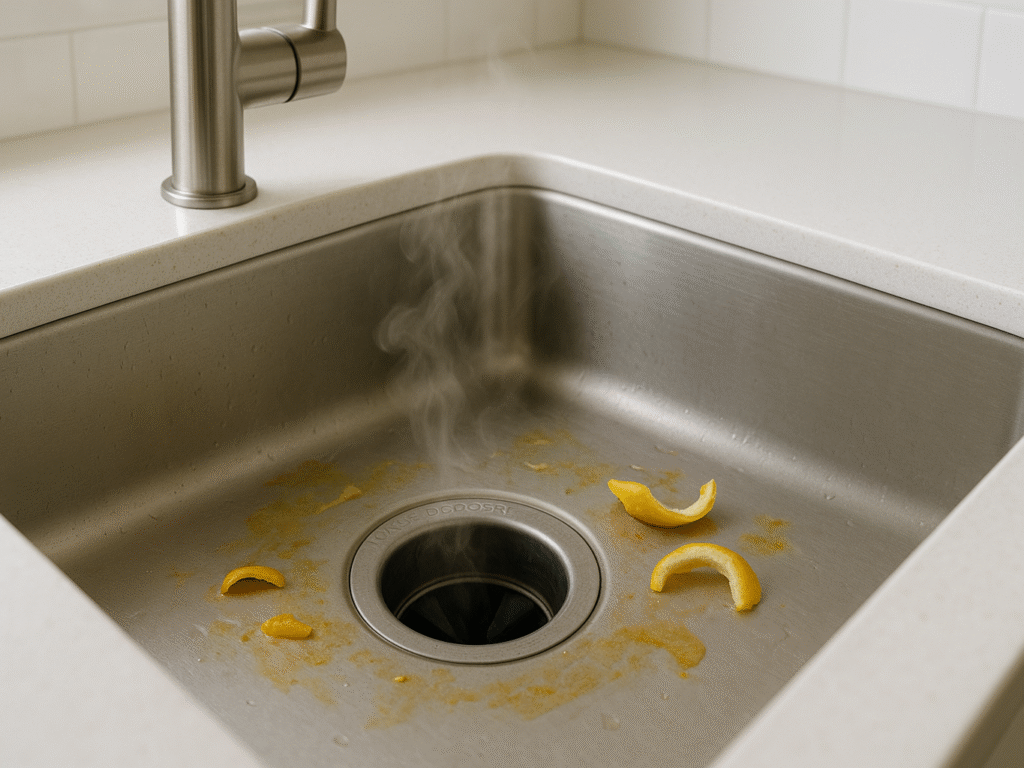
Contrary to popular belief, garbage disposals don’t use blades to break down food. Instead, they employ rotating impellers that grind food particles and flush them down the drain with water. This distinction helps explain why odors develop despite the unit’s self-cleaning design.
1. Common culprits: grease, food scraps, and bacteria
The primary source of garbage disposal odors is trapped food debris. When food particles aren’t completely ground or flushed away, they accumulate in various parts of the disposal. For comprehensive solutions to persistent odor problems, eliminating the garbage disposal smell requires addressing multiple causes simultaneously.
- Food residue buildup: Trapped food bits decompose, releasing strong odors into your kitchen sink area.
- Grease and fat deposits: Cooled grease hardens, trapping food and encouraging bacteria to grow inside the unit.
- Insufficient water usage: Too little water fails to flush particles, leading to buildup and persistent odors.
- Bacterial and mold growth: Warm, moist conditions allow bacteria to thrive and produce foul-smelling sink gases.
- Improper grinding techniques: Large or fibrous foods clog disposal parts, leading to odor-causing decomposition.
Furthermore, the rubber splash guard (that flappy piece at the drain opening) harbors significant numbers of bacteria in its crevices. The slime that develops on this component contains millions of microorganisms that contribute to disposal odors.
Food particles that accumulate over time can harden and encrust the grinding components, causing them to malfunction. Once this happens, simple rinsing or flushing with water becomes ineffective at removing the buildup. The decomposition of these trapped food remnants creates that characteristic rotting smell that can quickly permeate your entire kitchen.
2. Why regular cleaning is essential
Keeping your garbage disposal clean isn’t just about controlling bad smells; it’s essential for appliance longevity and kitchen hygiene. Regular cleaning prevents food particles from accumulating, which in turn attracts pests and fosters the growth of bacteria. A clean unit means fewer germs, a fresher kitchen, and a lower risk of health-related issues over time.
Routine maintenance also protects the disposal’s mechanical components. When food residue and grease accumulate, they clog and strain the grinding mechanism. Over time, this reduces efficiency and can lead to breakdowns. Weekly or biweekly cleaning ensures smooth operation and extends the lifespan of your appliance, saving you from costly repairs.
Failing to maintain your plumbing can lead to more potent and persistent odors, as well as potential plumbing clogs. Bacteria multiply, the smell worsens, and blockages form. Fortunately, simple ice-based cleaning methods dislodge trapped food, scrub grease, and prevent bacterial growth. These easy steps, done regularly, keep your disposal fresh, functional, and free from lingering kitchen odors.
The Quick Fix: How to Get Rid of the Garbage Disposal Smell Today. Need immediate relief from disposal odors? This comprehensive guide covers all the fastest methods to eliminate smells today. From emergency fixes to deep cleaning solutions, get your kitchen fresh in under 10 minutes with proven techniques. Click here for instant odor relief!
Trick 1: Ice and Cold Water Flush
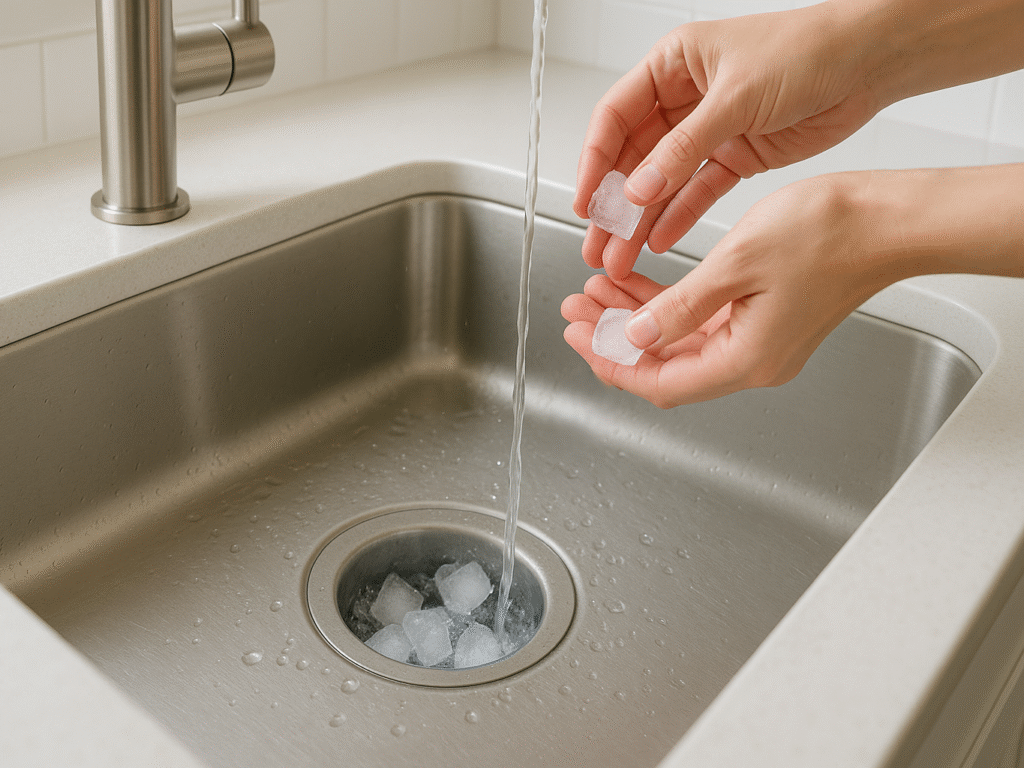
When learning how to get rid of garbage disposal smell with ice, ice cubes seem like an unlikely hero in your battle against disposal odors. Yet, plumbers and appliance experts consistently recommend this simple household item as an effective cleaning solution. This first trick combines the mechanical cleaning power of ice with the benefits of cold water to keep your disposal smelling fresh and functioning correctly.
(i) How ice helps dislodge stuck food
Understanding how to get rid of the garbage disposal smell with ice reveals that this method works primarily as a mechanical cleaner. Unlike liquid cleaners that merely coat the surface, ice provides a physical scrubbing action that reaches places where brushes and other cleaning tools cannot access.
When you drop ice cubes into your disposal, they act as natural scouring agents. As the frozen chunks tumble around the grinding chamber, they create an abrasive action that effectively scrapes away food residue and buildup clinging to the disposal walls and grinding components. This scrubbing action helps dislodge stubborn, stuck-on food debris that has become lodged in your disposal, the very debris that causes those unpleasant odors.
Ice cubes are particularly effective at cleaning because:
- They’re just hard enough to scrape away residue without damaging the disposal components
- The frozen chunks break up into smaller pieces that can reach crevices and corners
- As they’re ground up, the ice chips act as tiny scrubbers that scour hard-to-clean areas inside the disposal
- The cold temperature helps congeal any grease or oils, making them easier to break up and wash away
Some disposal units utilize impellers instead of traditional blades. In these cases, ice still provides effective cleaning by scouring the walls and other components of the grinding chamber. The abrasive action works regardless of the specific internal mechanism.
Many experts recommend using this method regularly as a form of preventative maintenance. Eric Schultz, director of product management at InSinkErator, suggests incorporating ice into a cleaning routine. If you have an InSinkErator unit specifically, learning how to prevent odors from the unit can provide brand-specific maintenance tips. Likewise, plumbing professionals often advise implementing this technique every other week to ensure debris isn’t building up on your disposal components.
To maximize the cleaning benefits, here’s how to properly execute the ice and cold water flush:
- Fill your sink with approximately 2 cups of ice cubes
- Turn on the cold water to a steady stream
- Turn on the garbage disposal
- Feed the ice cubes gradually into the disposal
- Continue running both the disposal and cold water until all ice is processed
- Let the cold water run for an additional 10-15 seconds after all ice is ground up
For added cleaning power, some experts recommend adding a few drops of lemon juice to your ice cubes before freezing them. It combines the mechanical scrubbing action with natural deodorizing properties.
(ii) Why is cold water better than hot water?
Contrary to what might seem intuitive, cold water is more effective than hot water when operating your garbage disposal, particularly when using the ice method. Understanding the reasoning behind this recommendation helps explain why this simple trick is so effective.
First and foremost, cold water helps prevent plumbing issues related to grease and fats. According to multiple plumbing experts, freezing water causes grease and oils to solidify, allowing your disposal to chop them into smaller particles before they reach the trap. In contrast, hot water liquefies these substances, allowing them to flow further down your drain pipes, where they eventually cool, solidify, and accumulate to form clogs.
Consider these additional benefits of using cold water with your disposal:
- Cold water helps keep the disposal motor from overheating during operation, extending the lifespan of your appliance.
- The cool temperature creates an optimal environment for the mechanical components, allowing the grinding process to work more efficiently.
- Unlike hot water, which can cause food particles to break down into smaller, odor-causing compounds that stick to the disposal, cold water keeps these particles solid and less likely to adhere to internal components.
- Using cold water can also save on energy costs compared to heating water for disposal.
Many disposal manufacturers, like GE, recommend using cold water, not hot, during operation. Cold water helps solidify food waste and fats, making them easier to flush down the drain. To prevent buildup, always run cold water for 10 seconds before, during, and after use. This habit ensures smoother operation and fewer odor-causing blockages.
Combining ice with cold water enhances the cleaning process. Ice scrubs away stuck debris while cold water flushes it out and prevents grease buildup. Experts advise doing this every two weeks, or more often with heavy use. It’s quick, inexpensive, and forms the foundation of an effective, odor-free maintenance routine.
(iii) Recommended Products
| Product Name | Brand | Price Range | Rating | Features | Amazon Link |
| Silicone Ice Cube Trays with Lids (4-Pack) | DOQAUS | $12-15 | 4.5/5 | BPA-free, stackable, easy-release, spill-resistant lids | Buy on Amazon |
| Stainless Steel Ice Cube Tray | ecozoi | $25-30 | 4.3/5 | 18 slots, eco-friendly, easy-release handle, dishwasher safe | Buy on Amazon |
| Large Ice Cube Tray for Big Cubes | Tovolo | $15-20 | 4.4/5 | 2-inch cubes, slow-melting, silicone construction | Buy on Amazon |
| Ice Cube Maker Storage Container | OXO | $20-25 | 4.6/5 | Airtight lid, easy pour spout, holds three trays worth of ice | Buy on Amazon |
Trick 2: Ice and Salt Combo
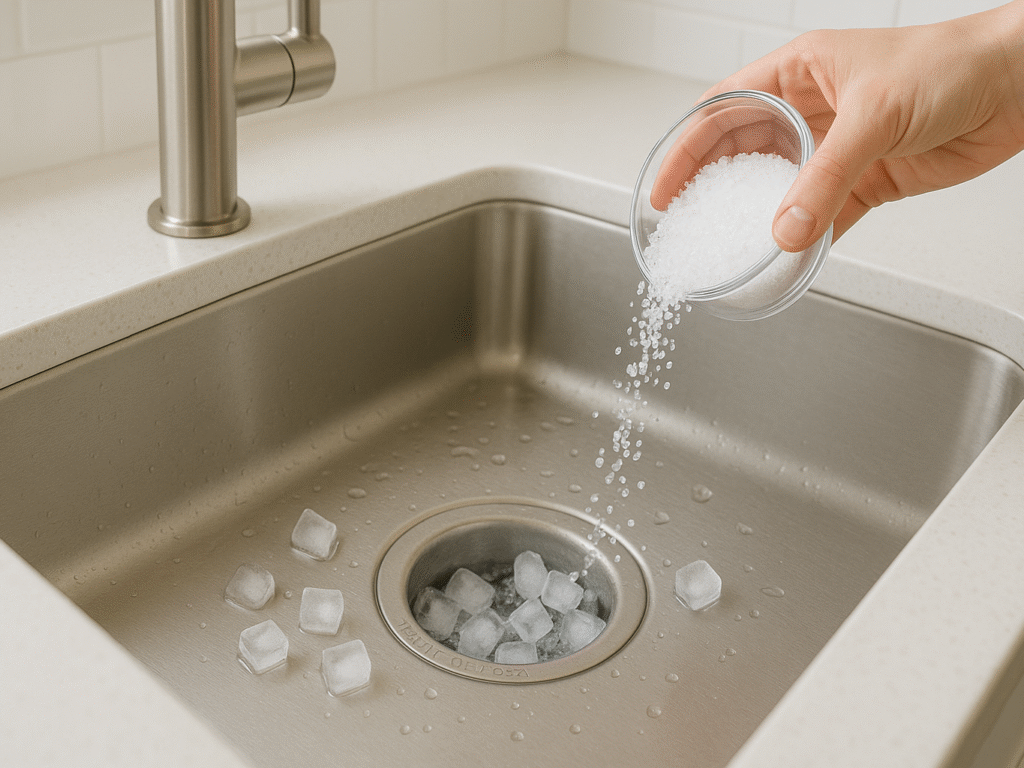
For those mastering how to get rid of garbage disposal smell with ice and seeking more power, combining salt with ice creates an effective scrubbing team that tackles even the toughest odors from garbage disposals. This dynamic duo works together to create an abrasive cleaning action that reaches places where ordinary cleaners cannot.
(i) How to clean a garbage disposal with ice and salt
The cleaning power of this combination comes from the way salt and ice work together. While ice alone provides good cleaning action, salt acts as an additional abrasive agent that helps scrub away stubborn residue from the disposal’s internal components. The coarse crystals of salt create friction against the ice, enhancing the scrubbing action against the walls and grinding elements of the disposal.
To properly learn how to clean a garbage disposal with ice and salt, follow these steps:
- Gather your materials: You’ll need about 2 cups of ice cubes and 1 cup of coarse salt. While rock salt is often recommended for its coarse texture, kosher or even regular table salt can serve as a suitable alternative in a pinch.
- Add the ice first: Pour the ice cubes directly into the garbage disposal chamber. Using tongs rather than your fingers is safer for pushing the ice further into the disposal.
- Add the salt: Sprinkle the salt over the ice cubes. The recommended ratio is approximately 2:1 (ice to salt), though some experts suggest using as little as half a cup of salt with 2 cups of ice.
- Run cold water: Turn on the cold water faucet so it flows into the disposal. Keep the water running throughout the entire process.
- Activate the disposal: Turn on the garbage disposal and let it run until all the ice and salt have been completely processed. It typically takes about 5 to 10 seconds.
- Continue the water flow: After the grinding stops, run cold water directly into the disposal for an additional 1-2 minutes. It helps flush away all the dislodged debris and residue.
- Check the results: Once complete, inspect the visible parts of your disposal for cleanliness and note any improvement in odor.
Alessandro Gazzo of Emily’s Maids, a house-cleaning service, recommends a slightly different approach, suggesting two tablespoons of salt be added to a large bowl of ice cubes. This alternative ratio may be sufficient for regular maintenance cleaning rather than deep cleaning.
The science behind this method is relatively straightforward – both salt and ice create friction between the grinding components. As the disposal crushes the ice and salt mixture, the abrasive combination scours the walls of the grinding chamber and the disposal’s components. This mechanical action helps remove slimy residue that has accumulated on the blades or impellers.
(ii) When to use this method
Understanding how to clean a garbage disposal with ice and salt is beneficial in specific situations requiring more cleaning power than ice alone can provide. Understanding when to deploy this method helps you maintain your garbage disposal more effectively.
This technique is especially beneficial:
- For deep cleaning sessions: When your disposal hasn’t been cleaned in a while and has developed persistent odors, the ice and salt combination provides more aggressive cleaning power than just ice alone. The abrasive action of salt helps remove buildup that has had time to harden on the disposal components.
- After processing greasy foods: If you’ve recently put oily or greasy food waste down your disposal, this method helps break down the slippery residue that ordinary rinsing might miss. The salt, in particular, helps cut through grease that can coat internal components.
- When dealing with stubborn odors: If you’ve noticed persistent smells emanating from your disposal despite regular rinsing, the ice and salt method provides more thorough cleaning action. It can reach areas where odor-causing bacteria hide.
- For monthly maintenance: Many experts recommend incorporating this technique into your monthly cleaning routine, even if there are no obvious odor problems. Regular maintenance prevents buildup from forming in the first place.
- After disposing of starchy foods: When you’ve processed items like pasta, potatoes, or rice that can create a paste-like residue inside your disposal, the ice and salt method helps dislodge these particularly sticky substances.
Mastering how to clean a garbage disposal with ice and salt offers more than surface cleaning; it scrubs the entire grinding chamber, including hard-to-reach spots. As ice crushes and salt dissolves, they form a gritty slurry that dislodges trapped food particles. This deep cleaning helps eliminate hidden odors and enhances the overall performance of your garbage disposal.
(iii) Recommended Products
| Product Name | Brand | Price Range | Rating | Features | Amazon Link |
| Morton Rock Salt for Ice Cream (4 lb) | Morton | $8-12 | 4.7/5 | Coarse texture, food grade, perfect for cleaning | Buy on Amazon |
| Diamond Crystal Kosher Salt (3 lb) | Diamond Crystal | $6-10 | 4.8/5 | Coarse flakes, pure salt, dissolve easily | Buy on Amazon |
| Redmond Real Salt Coarse (26 oz) | Redmond | $10-15 | 4.5/5 | Natural sea salt, coarse grind, unrefined | Buy on Amazon |
| Pink Himalayan Rock Salt Coarse (5 lb) | Sherpa Pink | $15-20 | 4.4/5 | Pure Himalayan salt, coarse crystals, mineral-rich | Buy on Amazon |
Garbage Disposal Burning Smell: Top Causes and Quick Fixes. Is your disposal producing burning odors instead of just bad smells? It could indicate serious mechanical issues. Learn to identify warning signs, understand when to call professionals, and discover safe troubleshooting steps to protect your appliance. Diagnose burning smells now!
Trick 3: Ice and Lemon Wedges
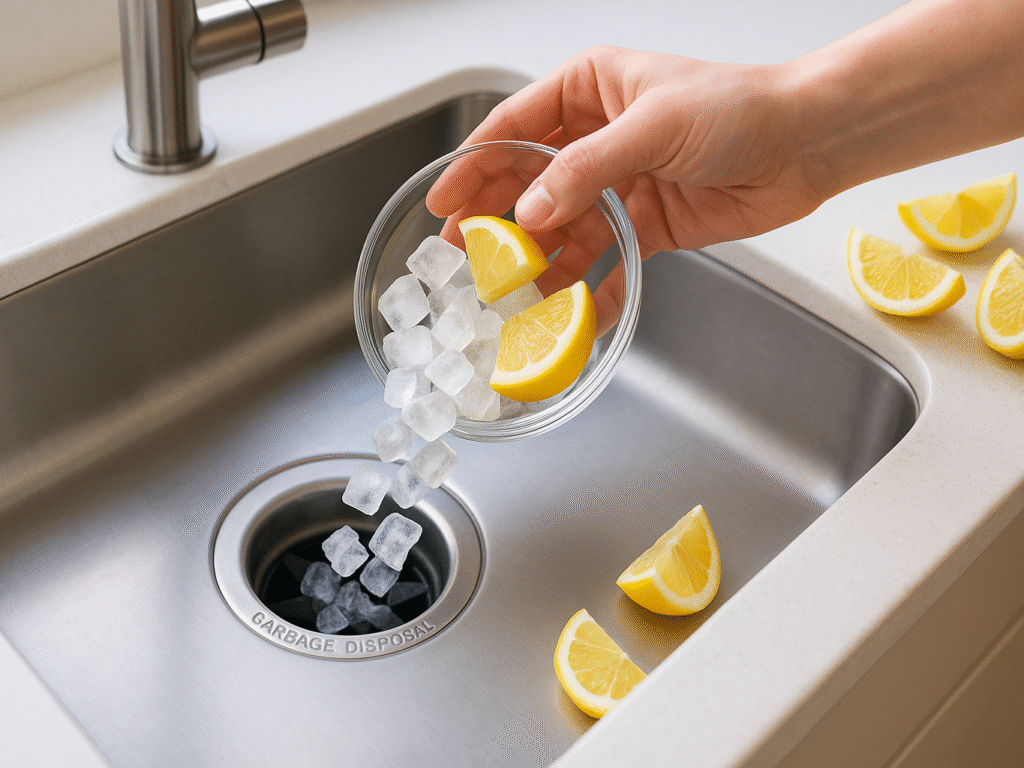
When exploring how to get rid of garbage disposal smell with ice, adding citrus elevates your maintenance routine to the next level by combining mechanical cleaning with the powerful natural deodorizing properties of citrus. The ice and lemon wedge method has gained popularity among homeowners and professionals alike for its dual-action approach to eliminating those persistent kitchen sink odors.
(i) Cleaning the garbage disposal with ice and lemon
Cleaning the garbage disposal with ice and lemon creates a powerful duo that tackles both physical debris and unpleasant odors. Simultaneously. This method builds upon the mechanical cleaning power of ice (discussed in previous tricks) by introducing natural citrus oils that cut through grease and eliminate odors.
To properly execute cleaning the garbage disposal with ice and lemon, follow this straightforward process:
- Prepare the lemons: Cut a whole lemon into quarters or eighths, including the rind. Alternatively, you can use leftover lemon peels from cooking or juicing.
- Add ice cubes: Place about 2 cups of ice cubes into the garbage disposal chamber. The ice provides the scrubbing action needed to dislodge food particles.
- Add the lemon pieces: Place the lemon wedges or peels on top of the ice. There’s no need to use the entire fruit; just a few pieces or peels will effectively deodorize your disposal.
- Run cold water: Turn on a steady stream of cold water. It helps flush away debris as it’s dislodged.
- Activate the disposal: Turn on the garbage disposal and let it process both the ice and lemon wedges completely. The grinding process might be louder than usual as the disposal works through the lemon rinds. It is normal and beneficial.
- Continue running water: After the grinding stops, keep the cold water running for an additional 30-90 seconds to flush away all loosened debris thoroughly.
Maria Rodriguez, a cleaning expert quoted in Bon Appétit, prefers using just lemons for maintenance cleaning: “The acidity of lemon juice can cut through grease and grime, and it has antibacterial properties that fight odors.” She recommends feeding each wedge into the disposal one at a time until you hear the grinding stop.
In contrast, Eric Schultz of InSinkErator suggests a combination approach, using 2 cups of ice cubes, one tablespoon of baking soda, and one lemon slice, all ground together with cold running water. This multi-ingredient method provides both scrubbing power and deodorizing effects in one treatment.
Beyond the basic cleaning, garbage disposal with the ice and lemon method, you can experiment with other citrus fruits. Orange, lime, tangerine, or grapefruit peels offer similar cleaning benefits and unique scent profiles. Consider combining different citrus peels to create a customized, fresh scent throughout your kitchen.
(ii) How lemon peels deodorize naturally
The effectiveness of lemon peels in deodorizing your garbage disposal isn’t just folk wisdom; it’s backed by science. Lemon peels contain high levels of limonene, a natural compound found abundantly in citrus fruits. This powerful substance possesses remarkable antibacterial and antifungal properties that directly combat the microorganisms causing disposal odors.
When you grind lemon peels in your disposal, the grinding action releases limonene and other essential oils contained within the rind. These natural compounds:
- Attack odor-causing bacteria: The oils actively combat bacteria and fungus growing in your disposal, eliminating the source of unpleasant smells rather than merely masking them.
- Break down grease and residue: Citric acid in lemons acts as a natural degreaser, cutting through the sticky buildup that commonly traps food particles and harbors bacteria.
- Provide lasting freshness: Unlike chemical deodorizers that temporarily mask smells, the natural oils in lemon peels provide longer-lasting freshness by actually eliminating the source of odors.
Citrus peels are powerful, natural scrubbers. Their firm texture helps clean and dispose of walls while grinding. Combined with ice, they remove buildup and release refreshing oils. This dual-action method breaks down residue and adds a fresh citrus scent that eliminates foul odors without relying on harsh chemical cleaners.
Citrus cleaning is a safe, eco-friendly, and budget-friendly option. Experts suggest using leftover peels weekly to keep your unit fresh. Lemon peels clean effectively without harming pipes or septic systems, making them ideal for regular maintenance. However, if you’re dealing with persistent musty odors that don’t respond to citrus cleaning, you may need to address garbage disposal smells, such as mold, with more targeted antimicrobial approaches. According to Koch, grinding used rinds and rinsing them with hot water maximizes both the use of citrus and the cleanliness of your disposal.
(iii) Recommended Products
| Product Name | Brand | Price Range | Rating | Features | Amazon Link |
| Organic Lemon Essential Oil (1 oz) | Plant Therapy | $8-12 | 4.6/5 | 100% pure, therapeutic grade, deodorizing properties | Buy on Amazon |
| Citrus Zester and Grater Tool | Microplane | $15-20 | 4.7/5 | Sharp stainless steel, ergonomic handle, perfect for peels | Buy on Amazon |
| Lemon Juice Concentrate (32 oz) | ReaLemon | $4-7 | 4.3/5 | Convenient bottled juice, equivalent to fresh lemons | Buy on Amazon |
| Silicone Lemon Ice Cube Molds | Tovolo | $12-16 | 4.5/5 | Novelty lemon-shaped cubes, easy release, fun design | Buy on Amazon |
Garbage Disposal Smells Like Mold? Here’s How to Clean It Fast. Musty, moldy odors require special attention and targeted cleaning approaches. This guide reveals professional techniques for eliminating mold growth, preventing future issues, and maintaining optimal disposal hygiene for healthier kitchen environments. Eliminate mold odors fast!
Trick 4: Ice, Baking Soda, and Vinegar
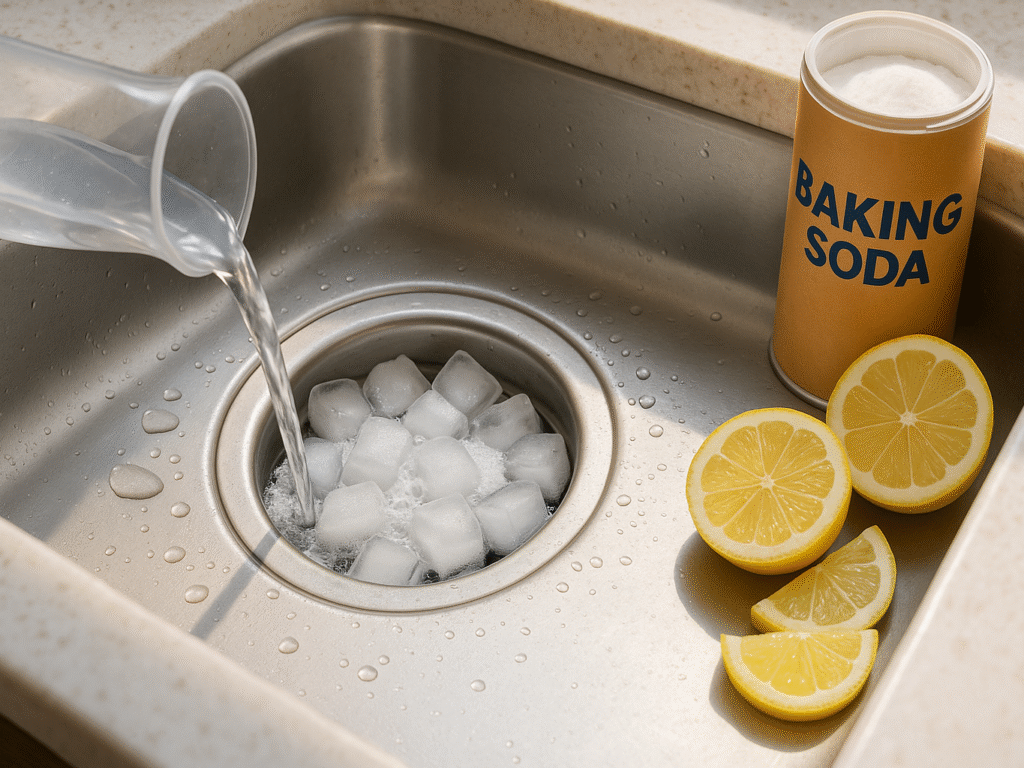
Learning how to get rid of garbage disposal smell with ice and powerful household cleaners creates an even more effective solution for eliminating stubborn odors from garbage disposals. This technique harnesses the fizzing action of baking soda and vinegar, combined with the scrubbing power of ice, for a deep-cleaning experience.
(i) How to clean a garbage disposal with ice and baking soda
This advanced technique for how to get rid of garbage disposal smell with ice combines mechanical cleaning with chemical action to attack odor-causing residue. To properly execute this technique, follow these steps:
- Start by pouring ½ cup of baking soda directly into your garbage disposal chamber.
- Next, add 2 cups of ice cubes on top of the baking soda.
- Finally, pour 1 cup of vinegar (white or apple cider) over the ice and baking soda.
- As the ingredients combine, you’ll notice immediate fizzing. This reaction helps loosen stuck-on food particles.
Eric Schultz recommends a variation of how to clean a garbage disposal with ice and baking soda, using 2 cups of ice cubes and one tablespoon of baking soda with one lemon slice.
For extra deodorizing power, some experts suggest adding lemon peels to this combination. The acid from the citrus works in conjunction with the vinegar to break down stubborn residue.
(ii) Letting the mixture sit before rinsing
Unlike other ice-based methods that require immediate grinding, this approach benefits from patience. After adding all ingredients:
- Allow the mixture to sit undisturbed for 5-15 minutes to maximize effectiveness.
- Different cleaning professionals recommend varying wait times, ranging from 3 minutes to half an hour, depending on the severity of the odor.
- The Moody Maids team specifically suggests letting the mixture work for 10 minutes before rinsing.
During this waiting period, the chemical reaction between baking soda and vinegar continues to work, dissolving buildup, while the ice helps control odors. This sitting time allows the fizzing action to reach deep into crevices where food particles hide.
Once the waiting period ends, run hot water from your faucet and turn on the garbage disposal until the mixture and loosened food particles have thoroughly washed away. The contrast between the ice and hot water creates thermal shock that helps dislodge additional residue.
This how to clean garbage disposal with ice and baking soda combination addresses not just surface odors but tackles bacteria throughout your disposal system. The baking soda neutralizes acidic odors while the vinegar’s acidity helps dissolve mineral deposits and kill germs, making it particularly effective for disposals that haven’t been cleaned in some time.
(iii) Recommended Products
| Product Name | Brand | Price Range | Rating | Features | Amazon Link |
| Arm & Hammer Baking Soda (4 lb) | Arm & Hammer | $5-8 | 4.8/5 | Pure sodium bicarbonate, deodorizing, food grade | Buy on Amazon |
| Heinz White Vinegar (1 Gallon) | Heinz | $4-7 | 4.7/5 | 5% acidity, distilled, all-natural cleaning power | Buy on Amazon |
| Bragg Organic Apple Cider Vinegar (32 oz) | Bragg | $8-12 | 4.6/5 | Raw, unfiltered, with “mother”, organic certified | Buy on Amazon |
| pH Test Strips for Cleaning Solutions | Hydrion | $10-15 | 4.4/5 | Monitor acidity levels, 0-14 pH range, 100 strips | Buy on Amazon |
How to Stop Your InSinkErator from Smelling: Quick & Easy Fixes. InSinkErator units have specific maintenance requirements and common causes of odors. Learn brand-specific cleaning techniques, troubleshooting tips, and maintenance schedules explicitly designed for InSinkErator garbage disposal systems. Fix your InSinkErator now!
Final Thoughts
Knowing how to get rid of a garbage disposal smell with ice makes maintaining a fresh-smelling disposal easy with simple methods. Options like ice and cold water, ice with salt, lemon ice cubes, or ice with baking soda and vinegar can powerfully clean your unit. These affordable, kitchen-friendly solutions scrub away debris and deodorize naturally without harsh chemicals. For additional comprehensive cleaning strategies and troubleshooting tips, exploring how to eliminate the garbage disposal smell provides even more professional-grade solutions for maintaining optimal disposal hygiene.
Routine care is crucial to prevent bad smells. Weekly or biweekly cleaning using these ice combos stops odor-causing buildup before it starts. Smart habits, like not dumping grease and always running cold water, also reduce the chance of residue sticking inside your disposal, making each cleaning more effective.
The best part? These natural methods protect your pipes and the environment. Ice acts like a scrubber, dislodging food particles, while lemon or vinegar kills odor-causing bacteria. With how to get rid of garbage disposal smell with ice techniques and basic ingredients, you can keep your disposal fresh, clean, and working smoothly, no fancy products or plumbers needed.
FAQs on how to get rid of a garbage disposal smell with ice
Q1. What is a simple household item to get rid of the garbage disposal smell?
Ice cubes are a surprisingly effective solution. They work as natural scouring agents, dislodging trapped food particles, grease, and debris that cause unpleasant odors in your garbage disposal, keeping it fresh and clean with minimal effort.
Q2. How do ice cubes help clean a garbage disposal?
As the disposal grinds the ice cubes, it physically scrubs the internal surfaces. This mechanical action helps remove stubborn residue from areas that are hard to reach with brushes, effectively reducing odors and improving the disposal’s overall performance.
Q3. Why is cold water recommended over hot water for garbage disposals?
Cold water solidifies grease and fats, allowing the disposal to break them down more effectively. Hot water melts these substances, causing them to coat pipes and form clogs farther down the drain system, which can lead to plumbing issues and odors.
Q4. What combination enhances the cleaning power of ice cubes in a garbage disposal?
Using coarse salt with ice cubes improves scrubbing power. The salt acts as an abrasive, helping to remove stuck-on food and grime, while the ice dislodges debris, making this combo ideal for deep, natural cleaning and odor elimination.

